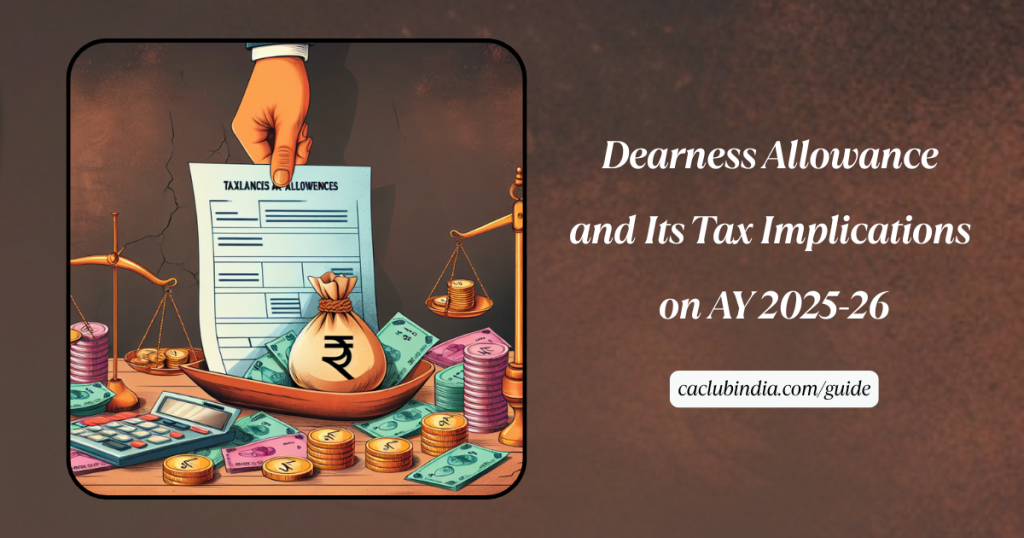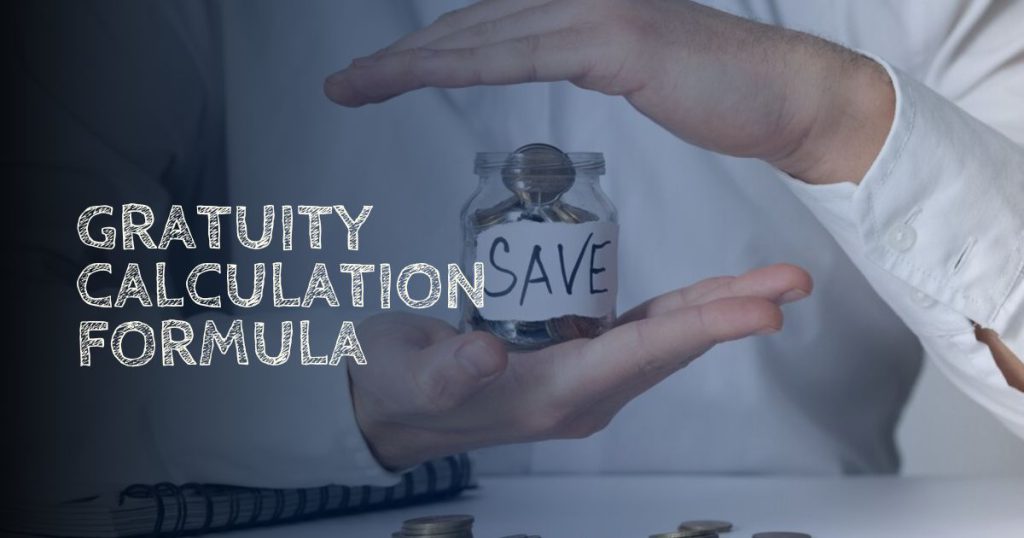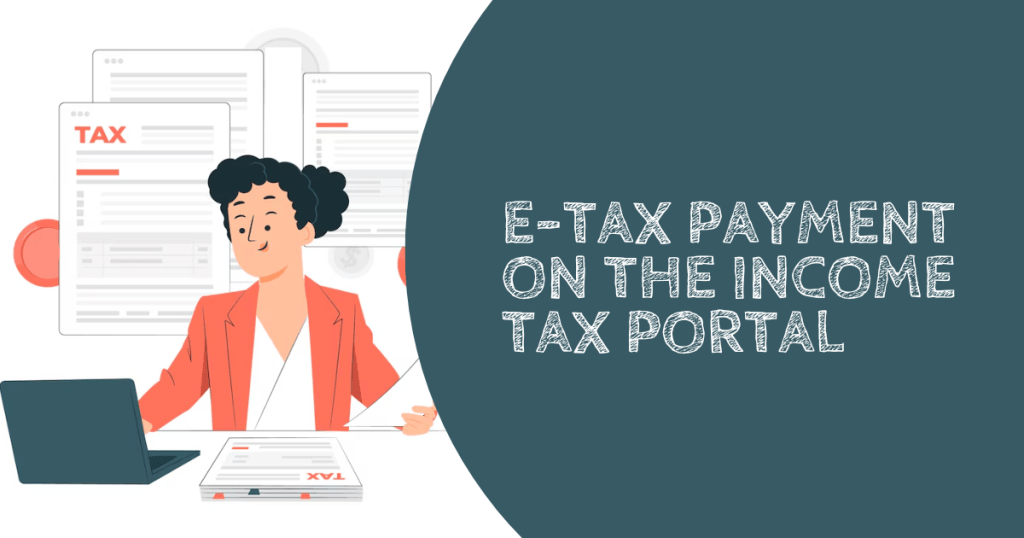Dearness Allowance is the additional payment the Government and Public Sector Entities make to their Employees and Pensioners.
Key Takeaways
- DA is part of salary; fully taxable
- Impacts HRA, gratuity, pension, PF
- No direct exemption, but it affects other deductions
- Needs correct placement in ITR to avoid mismatch
- Always cross-check with Form 16, 26AS
Introduction: Why DA Still Matters in 2024-25
Dearness Allowance (DA) may sound like a boring salary component, but it plays a vital role in your tax situation – especially with rising inflation and regular DA hikes. For many salaried individuals and pensioners, DA is a sizable part of their income, but it’s also fully taxable, and that’s where people slip up.
In FY 2024-25, with salary structures constantly changing and new tax rules in place, understanding how DA is taxed is more important than ever. It’s not just about how much you report it. Even a small mistake in declaring or calculating DA can affect your deductions, HRA claims, or pension reporting.
This article walks you through everything you need to know – without the jargon – so you can file your taxes the right way this year.
What is Dearness Allowance and Who Gets It?
Dearness Allowance (DA) is a cost-of-living adjustment paid by the government and public sector employers to help employees cope with inflation. It’s revised periodically – usually twice a year – based on the Consumer Price Index (CPI).
You’ll typically find DA in the payslips of:
- Central and State government employees
- Public sector undertakings (PSUs)
- Some private sector firms, though it’s less common
- Pensioners, especially government retirees, who get DA as a percentage of their basic pension
It may not seem like a big deal when you’re working, but over time, DA can add up to major chunk of your earnings or pension. And since it’s taxable, ignoring it during tax filing can lead to inaccurate income reporting.
DA as a part of Salary: How It’s Taxed
DA isn’t a separate type of income – it’s part of your salary package, and as per Indian tax rules, it’s fully taxable for both salaried employees and pensioners.
When your employer calculates your salary, DA is added to your basic pay. The entire amount (Basic + DA) is shown under the “Salary” head in your ITR. There are no direct exemptions on DA, which means it gets taxed according to your income tax slab.
Also, DA is considered for calculating other benefits like:
- Retirement benefits (gratuity, pension)
- Provident Fund contributions
- Leave encashment
If you’re filing under the new tax regime, DA is still included in your total income, and since most deductions are not allowed there, your taxable income may go up.
Treat DA like regular salary – it’s taxable the same way and needs to be declared correctly.
How to calculate Dearness Allowance?
Dearness Allowance is calculated as a percentage of Basic Salary. It is a fully taxable Allowance and can be in two forms,
- DA given under terms of employment
- DA not given under terms of employment
DA is calculated twice every year, on 1st January and 1st July.
The Dearness Allowance payments are an inflation adjustment and are linked to the Consumer Price Index. CPI is the weighted average price of a basket of goods purchased by households over time. In 2021, the Government revised the base year of the CPI-IW (Industrial Workers) Index from 2001 to 2016. A linking factor of 2.88 was determined in 2021 as well
Formula to Calculate Dearness Allowance
Formula for Central Government Employees:
| DA% = {(A – 261.4)/261.4}*100 Where A = Avg of CPI-IW (base 2016=100) for the past 12 months x linking factor of 2.88 |
Formula for Public Sector Employees:
| DA% = {(A – 126.33)/126.33}*100 Where A = Average of AICPI(Base year 2001=100) for the past 3 months |
Impact of DA on HRA and Other Salary Components
DA doesn’t just sit quietly in your salary – it influences how other components are calculated, especially House Rent Allowance (HRA) and retirement benefits.
If you live in rented accommodation and claim HRA, DA becomes important because:
- For HRA exemption under Section 10(13A), the calculation considers basic salary + DA (if part of retirement benefits).
- If your employer includes DA for calculating retirement benefits, it must also be included while calculating HRA exemption.
Ignoring this can either lead to under-claiming or over-claiming HRA, both of which can trigger notices from the department.
Apart from HRA, DA also impacts:
- Gratuity payouts
- Leave encashment amounts
- Pension and PF contributions
So even if DA feels like just a percentage in your payslips, it silently changes how big your other benefits – and your tax – turn out.
Is There Any Exemption on Dearness Allowance?
By itself, Dearness Allowance is fully taxable – there’s no direct exemption on the amount you receive. But there’s a catch: DA can influence exemptions indirectly, especially when linked with other components.
For instance,
- In HRA exemption, as explained earlier, DA becomes part of salary for calculation if it’s considered for retirement benefits.
- In gratuity or pension calculations, DA is often added to basic pay. This doesn’t make DA exempt – but it affects the exempt portion of gratuity under Section 10(10).
So, while DA itself can’t be exempted, it has a backdoor influence on how much of other benefits you can claim as tax-free. You can’t cut tax directly on DA, but you can manage other claims better by understanding where DA fits in.
DA for Pensioners
For pensioners, DA doesn’t go away – it continues as Dearness Relief (DR), especially for central and state government retirees. Just like doing service, this amount is fully taxable.
Here’s how it works:
- If you’re receiving a regular pension, DA is added to your pension and taxed as “Income from Salary”.
- If you’re receiving a family pension, the DA portion is already merged, and the whole amount is taxed under “Income from Other Sources”.
There are no separated exemptions for DA/DR pensioners. However, you can still claim:
Standard deduction of INR 50,000 (only for regular pensioners, and not for family pension).
Other deductions like 80C, 80D, 80TTB.
Common DA-Related Mistakes in Tax Filing
- Ignoring DA while calculating HRA exemption
- Reporting DA under allowances, not salary
- Pensioners missing DA in pension breakup
- Overlooking DA’s effect on retirement benefit exemptions
Even small errors here can lead to notice or loss of deductions.
How to Report DA in ITR Forms
- For salaried: Include DA under “salary” in ITR-1 or ITR-2
- For pensioners: Report regular pension with DA under “Salary” or family pension under “Other sources”.
- Use Form 16 or pension slips to match income
- Cross-verify with Form 26AS and AIS
DA and Tax Regimes: Old vs. New
DA is taxable under both regimes, but
- In old regime, you can claim HRA, standard deduction, etc.
- In new regime, most exemptions are removed, so DA adds more to taxable income.
Choose your regime based on overall tax outgo, not just DA impact.
Conclusion
DA might feel routine, but it shapes your tax. It’s fully taxable, affects other salary components, and can silently increase your liability if not reported right.
FAQs
Ans. No, DA is taxable under both old and new regimes—there’s no special exemption in either.
Ans. Only if your DA counts for retirement benefits, it should be included in your HRA exemption formula.
Ans. No. DA is usually merged with pension or relief and must be reported as part of total pension income—not separately.


